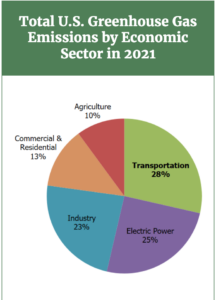When it comes to decarbonizing the U.S. economy, one could be forgiven for thinking the answer is as simple as ramping up wind and solar. While that is an option – albeit one that on its own would take decades – a more realistic approach is to identify what the most efficient and effective solutions are within different sectors. Different industries have different inputs and requirements, and a single electricity-centric solution may not apply well.
Consider that a top priority for many seeking to decarbonize the economy is to phase out or eliminate coal. If coal disappeared tomorrow, it would do nothing to impact vehicle emissions, which rely on petroleum products – not coal. Taking coal out of the equation only reduces the carbon intensity of the electricity generation sector and parts of the industrial sector.
 Exploring each sector will reveal the strengths and weaknesses of each and allow a more efficient decarbonization strategy to be crafted. For instance, the commercial and industrial sectors are major consumers of heat. They need high-intensity heat for everything from metal forging to chemical processes.
Exploring each sector will reveal the strengths and weaknesses of each and allow a more efficient decarbonization strategy to be crafted. For instance, the commercial and industrial sectors are major consumers of heat. They need high-intensity heat for everything from metal forging to chemical processes.
Heat is also central in the electricity generation sector, where it is used often in combination with steam to spin turbine generators. But the heat applications look different in this sector. This is also a place that direct electricity generation occurs, such as hydropower, wind, and solar.
Within electricity generation, these decarbonization strategies may work well, but solar is not likely to make strides to reducing vehicle emissions. In that sector, fuel efficiency, alternative fuels, hybrids, and electric vehicles may be more effective strategies for reducing overall emissions.
The takeaway is that the conversation around decarbonization often centers on solutions that apply well to one sector with an unstated assumption that they would help the total decarbonization effort. Unless or until the entire economy is electrified and every sector is connected to the grid or batteries, the approaches will need to differ significantly.
In the commercial and industrial sectors, existing infrastructure can be leveraged to promote effective decarbonization strategies. In particular, this helps avoid unnecessary new infrastructure buildouts. For electric power, improved efficiency and grid improvements can help integrate more renewables alongside traditional sources. A caveat is that more electricity transmission infrastructure is needed. In transportation, efficiency is key, applying directly to gasoline vehicles and making electric vehicles cost competitive. At the end of the day, the solutions must not only be tailored to the sector they are targeting, but cost effective and competitive so the solution is resilient and effective.
Written by Benjamin Dierker, Executive Director
The Alliance for Innovation and Infrastructure (Aii) is an independent, national research and educational organization. An innovative think tank, Aii explores the intersection of economics, law, and public policy in the areas of climate, damage prevention, energy, infrastructure, innovation, technology, and transportation.